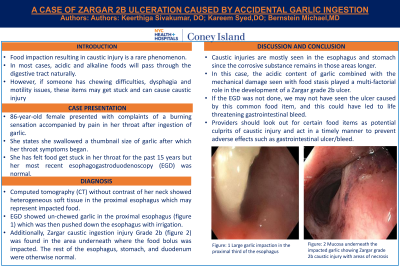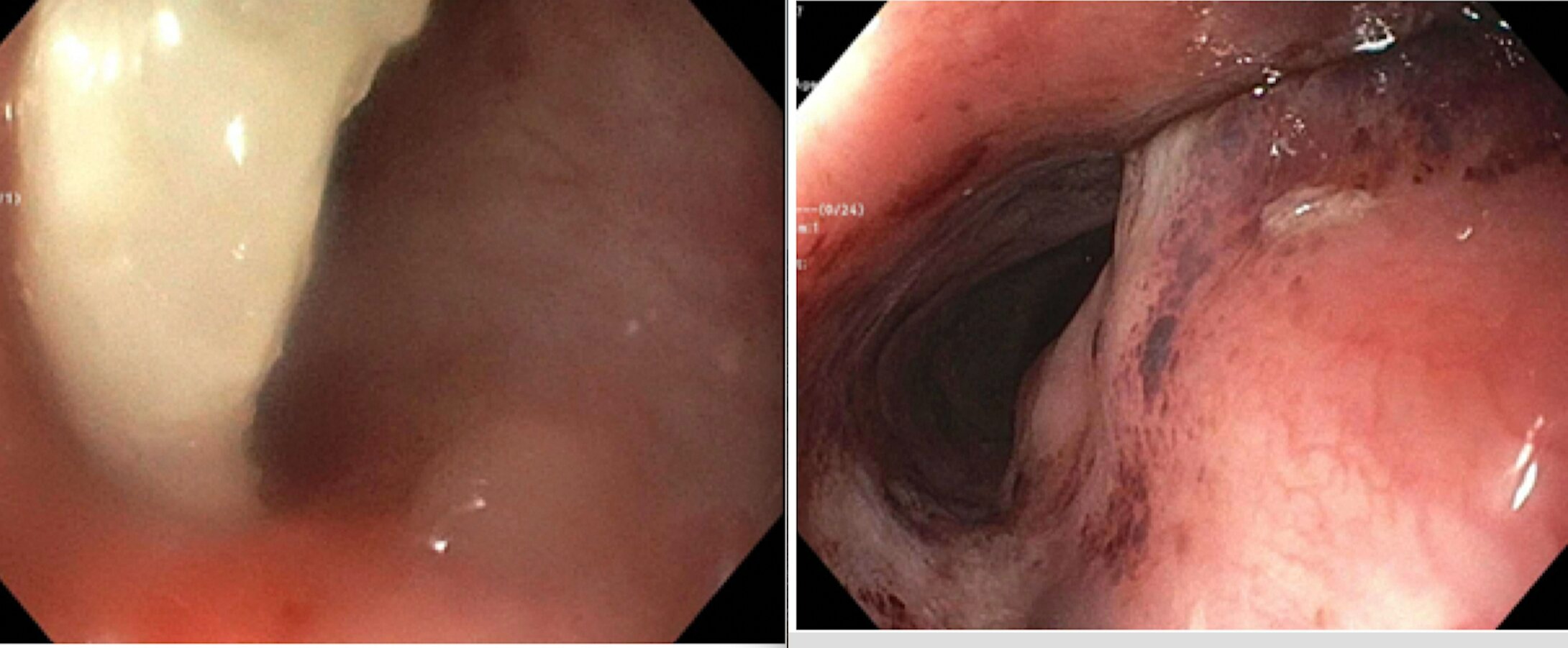Back


Poster Session D - Tuesday Morning
Category: Stomach
D0700 - A Case of Zargar 2B Ulceration Caused by Accidental Garlic Ingestion
Tuesday, October 25, 2022
10:00 AM – 12:00 PM ET
Location: Crown Ballroom

Has Audio
- KS
Keerthiga Sivakumar, DO
Coney Island Hospital
Brooklyn, NY
Presenting Author(s)
Keerthiga Sivakumar, DO, Michael Bernstein, MD, Syed Kareem, DO
Coney Island Hospital, Brooklyn, NY
Introduction: Food impaction resulting in caustic injury is a rare phenomenon. In most cases, acidic and alkaline foods will pass through the digestive tract naturally. However, if someone has chewing difficulties, dysphagia, and motility issues, these items can easily be stuck and can cause caustic injury.
Case Description/Methods: A 86 year old female with a medical history of myocardial infarction with 2 stents and right branch bundle block presented with a burning sensation accompanied by pain in her throat after ingestion of garlic. She swallowed a thumbnail size of garlic. She also mentioned that she has had episodes of food impaction before, which had passed without any intervention, and her most recent esophagogastroduodenoscopy was normal. The physical exam was unremarkable and laboratory values were within normal limits.
Computed tomography (CT) of her neck showed heterogeneous soft tissue in the proximal esophagus representing impacted food. Urgent EGD showed un-chewed garlic in the proximal esophagus which was then pushed down the esophagus with irrigation. Additionally, Zargar caustic ingestion injury Grade 2b was found in the area underneath where the food bolus was impacted. The rest of the esophagus, stomach, and duodenum were otherwise normal. She was diagnosed with garlic-induced ulceration just distal to the upper esophageal sphincter (UES) and started on a proton pump inhibitor 40 mg twice a day and was on a soft diet. She later had a follow-up EGD in 2 weeks which showed complete healing.
Discussion: Caustic injuries are mostly seen in the esophagus and stomach since the corrosive substance remains in those areas longer. In this case, the acidic content of garlic combined with the mechanical damage was seen with food stasis and played a multi-factorial role in the development of a Zargar grade 2b ulcer. Due to this, our patient was treated with the same degree of precautions as other caustic injury patients to prevent potential long-term complications such as strictures, and carcinoma. As demonstrated in this case, a common food item, such as garlic, caused serious chemical injuries resulting in Zargar grade 2b ulcer due to its acidic contents. Garlic has a PH value of around 5.8. Providers should not overlook food in both contents, whether alkaline or acidic and size as potential culprits of caustic injury and act in a timely manner to prevent adverse effects such as gastrointestinal ulcer/bleed.

Disclosures:
Keerthiga Sivakumar, DO, Michael Bernstein, MD, Syed Kareem, DO. D0700 - A Case of Zargar 2B Ulceration Caused by Accidental Garlic Ingestion, ACG 2022 Annual Scientific Meeting Abstracts. Charlotte, NC: American College of Gastroenterology.
Coney Island Hospital, Brooklyn, NY
Introduction: Food impaction resulting in caustic injury is a rare phenomenon. In most cases, acidic and alkaline foods will pass through the digestive tract naturally. However, if someone has chewing difficulties, dysphagia, and motility issues, these items can easily be stuck and can cause caustic injury.
Case Description/Methods: A 86 year old female with a medical history of myocardial infarction with 2 stents and right branch bundle block presented with a burning sensation accompanied by pain in her throat after ingestion of garlic. She swallowed a thumbnail size of garlic. She also mentioned that she has had episodes of food impaction before, which had passed without any intervention, and her most recent esophagogastroduodenoscopy was normal. The physical exam was unremarkable and laboratory values were within normal limits.
Computed tomography (CT) of her neck showed heterogeneous soft tissue in the proximal esophagus representing impacted food. Urgent EGD showed un-chewed garlic in the proximal esophagus which was then pushed down the esophagus with irrigation. Additionally, Zargar caustic ingestion injury Grade 2b was found in the area underneath where the food bolus was impacted. The rest of the esophagus, stomach, and duodenum were otherwise normal. She was diagnosed with garlic-induced ulceration just distal to the upper esophageal sphincter (UES) and started on a proton pump inhibitor 40 mg twice a day and was on a soft diet. She later had a follow-up EGD in 2 weeks which showed complete healing.
Discussion: Caustic injuries are mostly seen in the esophagus and stomach since the corrosive substance remains in those areas longer. In this case, the acidic content of garlic combined with the mechanical damage was seen with food stasis and played a multi-factorial role in the development of a Zargar grade 2b ulcer. Due to this, our patient was treated with the same degree of precautions as other caustic injury patients to prevent potential long-term complications such as strictures, and carcinoma. As demonstrated in this case, a common food item, such as garlic, caused serious chemical injuries resulting in Zargar grade 2b ulcer due to its acidic contents. Garlic has a PH value of around 5.8. Providers should not overlook food in both contents, whether alkaline or acidic and size as potential culprits of caustic injury and act in a timely manner to prevent adverse effects such as gastrointestinal ulcer/bleed.

Figure: Figure 1: Large garlic impaction in the proximal third of the esophagus.
Figure 2: Mucosa underneath the impacted garlic showing Zargar grade 2b caustic injury with areas of necrosis
Figure 2: Mucosa underneath the impacted garlic showing Zargar grade 2b caustic injury with areas of necrosis
Disclosures:
Keerthiga Sivakumar indicated no relevant financial relationships.
Michael Bernstein indicated no relevant financial relationships.
Syed Kareem indicated no relevant financial relationships.
Keerthiga Sivakumar, DO, Michael Bernstein, MD, Syed Kareem, DO. D0700 - A Case of Zargar 2B Ulceration Caused by Accidental Garlic Ingestion, ACG 2022 Annual Scientific Meeting Abstracts. Charlotte, NC: American College of Gastroenterology.
